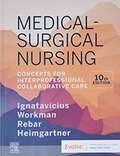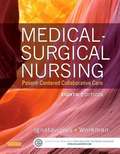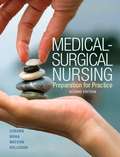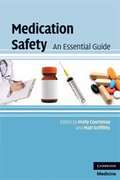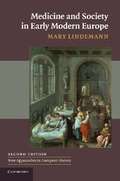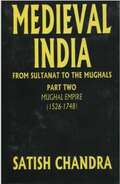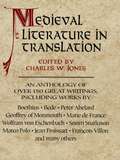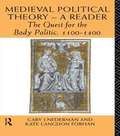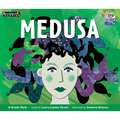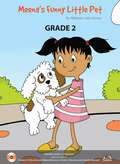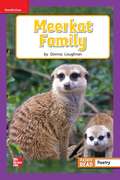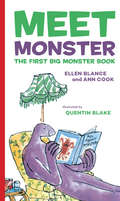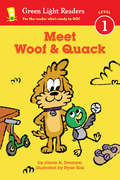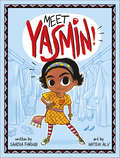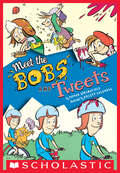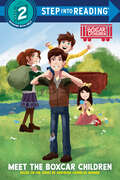- Table View
- List View
Medical-Surgical Nursing: Concepts for Interprofessional Collaborative Care
by Donna D. Ignatavicius Cherie R. Rebar Nicole M. Heimgartner Linda WorkmanMaster the essential medical-surgical nursing content you’ll need for success on the Next Generation NCLEX® Exam (NGN) and safe clinical practice! <p><P>Medical-Surgical Nursing: Concepts for Interprofessional Collaborative Care, 10th Edition uses a conceptual approach to provide adult health knowledge and help you develop the clinical nursing judgment skills that today’s medical-surgical nurses need to deliver safe, effective care. "Iggy" emphasizes three emerging trends in nursing ― interprofessional collaborative care, concept-based learning, and clinical judgment and systems thinking ― trends that will ground you in how to think like a nurse and how to apply your knowledge in the classroom, simulation laboratory, and clinical settings. <p><p>A perennial bestseller, "Iggy" also features NCLEX Exam-style Challenge and Mastery questions to prepare you for success on the NGN
Medical-Surgical Nursing: Patient Centered Collaborative Care, 8th Edition
by Donna D. Ignatavicius M. Linda WorkmanUsing a unique collaborative care approach to adult health nursing, this edition covers the essential knowledge you need to succeed at the RN level of practice.
Medical-Surgical Nursing: Patient-Centered Collaborative Care (Volume 1, 7th Edition)
by Donna D. Ignatavicius M. Linda WorkmanUsing a uniquely collaborative and reader-friendly approach, expert authors Donna D. Ignatavicius and M. Linda Workman cover all the latest trends, evidence-based treatment guidelines, and additional updated information needed for safe clinical practice in medical-surgical nursing. This seventh edition features an expanded emphasis on patient safety and NCLEX Examination preparation, new ties to the QSEN priorities for patient safety, and a greater alignment with the language and focus of clinical practice. A new chapter on evidence-based practice and a wealth of effective online learning tools help solidify your mastery of medical-surgical nursing. UNIQUE! Collaborative approach presents all medical, surgical, nursing, and other interventions through the lens of the nursing process. Reader-friendly, direct writing style makes this one of the most readable medical-surgical nursing textbooks available. UNIQUE! Cutting-edge focus on the latest trends in nursing practice and nursing education prepares you for both today and tomorrow''s nursing practice. UNIQUE! Integrated tools for NCLEX preparation get you ready for your licensure examination. Chapter-opening Learning Outcomes are linked to Self-Assessment Questions for the NCLEX Examination on the Evolve website. Unique chapter-ending Get Ready for the NCLEX Examination! sections include Key Points organized by NCLEX Client Needs Categories. UNIQUE! Focus on nursing concepts helps bridge the gap between the concepts learned in Nursing Fundamentals, and disorders content learned in the medical-surgical nursing course. UNIQUE! Emphasis on clinical decision-making teaches you to apply concepts to true-to-life clinical situations. UNIQUE! Concentration on the core body of knowledge for the RN level of medical-surgical nursing practice focuses your attention on "need-to-know" content to pass the NCLEX Examination and practice safely as a beginning nurse. Rich array of effective learning aids includes: Best Practice for Patient Safety & Quality Care Best Practice for Emergency Care Patient and Family Education: Preparing for Self-Management Nursing Focus on the Older Adult Home Care Assessment Focused Assessment Common Examples of Drug Therapy Evidence-Based Practice Concept Maps Laboratory Profiles Assessment Using Gordon''s Functional Health Patterns Patient safety is emphasized throughout with Nursing Safety Priority features, including Drug Alerts, Critical Rescue, and Action Alerts. More NCLEX Examination preparation, including integrated NCLEX Examination Challenges to prepare you for the types of questions you will see on today''s NCLEX Examination. Greater use of realistic clinical language familiarizes you with the terminology actually used by nurses, physicians, and other healthcare professionals in clinical practice today. Streamlined, prioritized coverage of the nursing process highlights the most important patient problems, regardless of whether they can be addressed by independent nursing actions or must be addressed by collaborative interventions. UNIQUE! New ties to QSEN competencies for patient safety inform you of the best safety practices in medical-surgical nursing. More coverage of evidence-based practice teaches you how to appraise the validity of research and provides synopses of recent nursing research and other evidence-based articles. Student Resources on Evolve include animations, video clips, audio clips, tutorials, Review Questions for the NCLEX Examination, and more. Improved layout and design streamlines content for an easier reading experience. Coverage of core genetics competencies acquaints you with new research demonstrating a genetic component to many diseases and disorders. Increased emphasis on health promotion and promotion of self-care offers strategies for helping people recover from illness and stay well and prevent illness. All-new Concept Maps match the streamlined nursing process format of the text and employ more creative, visually oriented symbols.
Medical-Surgical Nursing: Patient-Centered Collaborative Care (Volume 2, 7th Edition)
by Donna D. Ignatavicius M. Linda WorkmanUsing a uniquely collaborative and reader-friendly approach, expert authors Donna D. Ignatavicius and M. Linda Workman cover all the latest trends, evidence-based treatment guidelines, and additional updated information needed for safe clinical practice in medical-surgical nursing. This seventh edition features an expanded emphasis on patient safety and NCLEX Examination preparation, new ties to the QSEN priorities for patient safety, and a greater alignment with the language and focus of clinical practice. A new chapter on evidence-based practice and a wealth of effective online learning tools help solidify your mastery of medical-surgical nursing. UNIQUE! Collaborative approach presents all medical, surgical, nursing, and other interventions through the lens of the nursing process. Reader-friendly, direct writing style makes this one of the most readable medical-surgical nursing textbooks available. UNIQUE! Cutting-edge focus on the latest trends in nursing practice and nursing education prepares you for both today and tomorrow''s nursing practice. UNIQUE! Integrated tools for NCLEX preparation get you ready for your licensure examination. Chapter-opening Learning Outcomes are linked to Self-Assessment Questions for the NCLEX Examination on the Evolve website. Unique chapter-ending Get Ready for the NCLEX Examination! sections include Key Points organized by NCLEX Client Needs Categories. UNIQUE! Focus on nursing concepts helps bridge the gap between the concepts learned in Nursing Fundamentals, and disorders content learned in the medical-surgical nursing course. UNIQUE! Emphasis on clinical decision-making teaches you to apply concepts to true-to-life clinical situations. UNIQUE! Concentration on the core body of knowledge for the RN level of medical-surgical nursing practice focuses your attention on "need-to-know" content to pass the NCLEX Examination and practice safely as a beginning nurse. Rich array of effective learning aids includes: Best Practice for Patient Safety & Quality Care Best Practice for Emergency Care Patient and Family Education: Preparing for Self-Management Nursing Focus on the Older Adult Home Care Assessment Focused Assessment Common Examples of Drug Therapy Evidence-Based Practice Concept Maps Laboratory Profiles Assessment Using Gordon''s Functional Health Patterns Patient safety is emphasized throughout with Nursing Safety Priority features, including Drug Alerts, Critical Rescue, and Action Alerts. More NCLEX Examination preparation, including integrated NCLEX Examination Challenges to prepare you for the types of questions you will see on today''s NCLEX Examination. Greater use of realistic clinical language familiarizes you with the terminology actually used by nurses, physicians, and other healthcare professionals in clinical practice today. Streamlined, prioritized coverage of the nursing process highlights the most important patient problems, regardless of whether they can be addressed by independent nursing actions or must be addressed by collaborative interventions. UNIQUE! New ties to QSEN competencies for patient safety inform you of the best safety practices in medical-surgical nursing. More coverage of evidence-based practice teaches you how to appraise the validity of research and provides synopses of recent nursing research and other evidence-based articles. Student Resources on Evolve include animations, video clips, audio clips, tutorials, Review Questions for the NCLEX Examination, and more. Improved layout and design streamlines content for an easier reading experience. Coverage of core genetics competencies acquaints you with new research demonstrating a genetic component to many diseases and disorders. Increased emphasis on health promotion and promotion of self-care offers strategies for helping people recover from illness and stay well and prevent illness. All-new Concept Maps match the streamlined nursing process format of the text and employ more creative, visually oriented symbols.
Medical-Surgical Nursing: Preparation for Practice (2nd Edition)
by Kathleen S. Osborn Cheryl E. Wraa Renee S. Holleran Annita S. WatsonExtensively updated to reflect new evidence and improved standards of care, MEDICAL-SURGICAL NURSING, 2nd Edition fully exposes learners to concepts that are essential to modern medical-surgical nursing practice. It identifies and defines 58 key concepts associated with caring, critical thinking, research, nursing process, and health promotion; and weaves each of these throughout the text, establishing a strong foundation for practice. Through "experiential learning" techniques, readers become active participants, with many opportunities to demonstrate their understanding in diverse modern nursing settings. This edition's content has been reorganized to support more efficient and intuitive learning. Major improvements include: tighter alignment with Institute of Medicine findings, including QSEN and Nursing Core Competencies; restructured coverage of Nursing Process/Patient Care Plans to support Gordon's functional health patterns; and increased emphasis on prevention, community-based care, collaboration, and the role of nurses as key members of the health care team.
Medication Safety
by Molly Courtenay Matt GriffithsThe supply and administration of medicines is an area of practice in which a number of healthcare professionals (e.g. nurses, pharmacists and allied health professionals) are involved. Prescribing is a relatively new role which many of these healthcare professionals have adopted. Medication Safety focuses on promoting safety in the delivery of medicines. Chapters explore the various stages in the medication process including safety in prescribing, dispensing and administering drugs. Adverse reactions, parenteral administration, dosage calculations, safety with controlled drugs, and reporting errors and near misses are all addressed in evidence-based contributions from a highly experienced team of contributors. This text is essential reading for all healthcare professionals involved in the delivery of medicines to patients.
Medicine and Society in Early Modern Europe
by Mary LindemannThis book offers students a concise introduction to health and healing in Europe from 1500 to 1800. Bringing together the best recent research in the field, the author examines medicine from a social and cultural perspective, rather than a narrowly scientific one. <p><p> Drawing on medical anthropology, sociology, and ethics as well as cultural and social history, she focuses on the experience of illness and on patients and folk healers as much as on the rise of medical science, doctors, and hospitals. This second edition has been updated and revised throughout in content, style, and interpretations, and new material has been added, in particular, on colonialism, exploration, and women. <p><p> Accessibly written and full of fascinating insights, this will be essential reading for all students of the history of medicine and will provide invaluable context for students of early modern Europe more generally.
Medieval History of India - Competitive Exam
by Indic TrustThis is a compilation of questions answer of Medieval History of India For Civil Services Competitive Examinations.
Medieval India: From Sultanat To The Mughals (Mughal Empire (1526 1748) Part Two)
by Satish ChandraMedieval India From Sultanat To The Mughals- Mughal Empire (1526-1748) - 2 by Satish Chandra can be regarded as an authentic and comprehensive account of India's medieval history, the book also explains the historical events that led to the foundation of the Mughal empire in India.
Medieval Literature in Translation
by Charles W. JonesComprehensive anthology contains exquisite cross-section of Western medieval literature, from Boethius and Augustine to Dante, Abelard, Marco Polo, and Villon, masterfully translated by Dante Gabriel Rossetti, Charles Eliot Norton, C. K. Scott Moncrieff, Lord Tennyson, Sir Walter Scott, Thomas Carlyle, Matthew Arnold, Lord Byron, others. "No better anthology exists." -- Commonweal.
Medieval Political Theory: The Quest for the Body Politic, 1100-1400
by Cary J. Nederman Kate L. ForhanA textbook anthology of important works of political thought revealing the development of ideas from the 12th to the 15th centuries. Includes new translations of both well-known and ignored writers, and an introductory overview.
Medieval and Early Modern World History: Core Text Companion (Discovery Education Social Studies Techbook)
by Discovery EducationDiscovery Education Social Studies Techbook for California - Core Text Companion - Medieval and Early Modern World History
Medioambientes extremos (¡Arriba la Lectura!, Level V #71)
by Deborah UnderwoodNIMAC-sourced textbook. ¿Dónde quedan los lugares más fríos de la Tierra? ¿Y los desiertos más secos? Encuentra la respuesta a estas preguntas y descubre cómo son los medioambientes más extremos del planeta.
Medusa: A Greek Myth
by Laura Layton Strom Laura Strom Stefania BisaccoMedusa brags and brags about her beauty. She loves to look in the mirror. She loves to tell others that she is the prettiest. Find out what happens when a young lady spends all of her time bragging.
Medusas y pulpos (¡Arriba la Lectura!, Level M #29)
by Elsie NelleyLas medusas y los pulpos son criaturas marinas. Descubre cómo son, qué comen y por qué algunas de ellas están entre las criaturas más peligrosas del océano. NIMAC-sourced textbook
Meena's Furry Little Pet class 2 - MIE
by Melanie Julia Annea"Meena’s Furry Little Pet" is an engaging big book tailored for Grade 2 English sessions, authored by Melanie Julia Annea and illustrated by Crishma Uckiah and Vedita Jokhun. The story revolves around Meena and her playful pet dog, Fluffy. Meena engages in a spirited game of hide and seek with Fluffy, searching in various places around the house until discovering Fluffy happily playing in the garden. However, when Fluffy gets dirty, Meena attempts to give it a bath, only to meet with resistance from the pet. Despite her efforts, Fluffy manages to stay clean by unexpectedly running into the water from her father's watering can. The story unfolds with humor and playful interactions between Meena and her furry pet, highlighting the simple joys and challenges of caring for a pet. The book's interactive sessions aim to enhance comprehension and vocabulary while encouraging creative activities for young learners, making the English learning experience enjoyable and enriching.
Meet Monster: The First Big Monster Book (Monster Bks. #Bk. 5)
by Ellen Blance Ann CookMonster is curious about making friends, finding a home, and exploring his city. This book collects six Monster stories—written by educators Ellen Blance and Ann Cook, who worked with children to write the books—brought to life by Quentin Blake's charming illustrations. Have you met Monster? He&’s not scary or mean like other monsters. He&’s kind of tall and his head is skinny, and he&’s purple. He&’s curious about everything: the city, the river, houses, cars, trains, and what people look like, the park, the kids, the swings, the stores and clothes and stuff. It is all new to him. &“Monster thinks the city is fine so he thinks he will live here.&” So begins the story of gentle, playful Monster, who conducts himself with grace and courtesy, and in short order finds a home, a best friend, and a bunch of kids to play with. First introduced in 1973, Monster returns in this omnibus edition of the first six stories of an extended emerging-reader series written not only for children, but also by them. Educators Ellen Blance and Ann Cook worked with schoolchildren to write stories a child would want, and be able, to read. While most children&’s books are meant to be read by adults to children, these are stories children can read to themselves or to adults. The book includes illustrations by the illustrious Quentin Blake, and a new letter to children (and one to parents) by the authors.
Meet Woof and Quack (Green Light Readers Level 1)
by Jamie Swenson Ryan SiasMeet Woof and Quack, a fun pair of pals who defy dog and duck stereotypes. Woof absolutely does not like to fetch—not a ball, not a banana, not that lovely cake. Good thing Quack likes to fetch! The results are laugh-out-loud comical in the debut of this exuberant beginning reader series that’s perfect for fans of Elephant and Piggie and Ballet Cat. Story unfolds in speech bubbles on colorful pages brimming with easy-to-read banter, fun-to-repeat phrases, and silly sound effects—SWOOSH! WHOOSH! WOBBLE! SPLAT!
Meet Yasmin! (Yasmin)
by Saadia FaruqiMeet Yasmin! Yasmin is a spirited second-grader who's always on the lookout for those "aha" moments to help her solve life's little problems. Taking inspiration from her surroundings and her big imagination, she boldly faces any situation, assuming her imagination doesn't get too big, of course! A creative thinker and curious explorer, Yasmin and her multi-generational Pakistani American family will delight and inspire readers.
Meet the Bobs and Tweets (Bobs and Tweets #1)
by Pepper SpringfieldOn Bonefish Street live two very different families......the Bobs, who are messy, and the Tweets, who are neat. How can these two strange families get along in the same neighborhood? And are all the Tweets really neat and all the Bobs slobs? This is the first book in a brand-new series of full-color, illustrated high-interest rhyming stories that's just right for reluctant readers. It's Dr. Seuss meets Captain Underpants wrapped into one zany adventure. Get ready to read...and laugh!
Meet the Boxcar Children: Boxcar Children Early Reader (Step into Reading) (Step into Reading)
by Gertrude Chandler WarnerThe Alden children were searching for a home—and found a life of adventure! Beloved by generations of families, the first book in the Boxcar Children series--adapted into this Step 2 leveled reader—is full of wholesome fun, perfect for children who are learning to read simple sentences. Henry, Jessie, Violet, and Benny are brothers and sisters. They're orphans too, and the only way they can stay together is to make it on their own. When the children find an abandoned boxcar in the woods, they decide to call it home—and become the Boxcar Children!Step 2 Readers use basic vocabulary and short sentences to tell simple stories. For children who recognize familiar words and can sound out new words with help.
